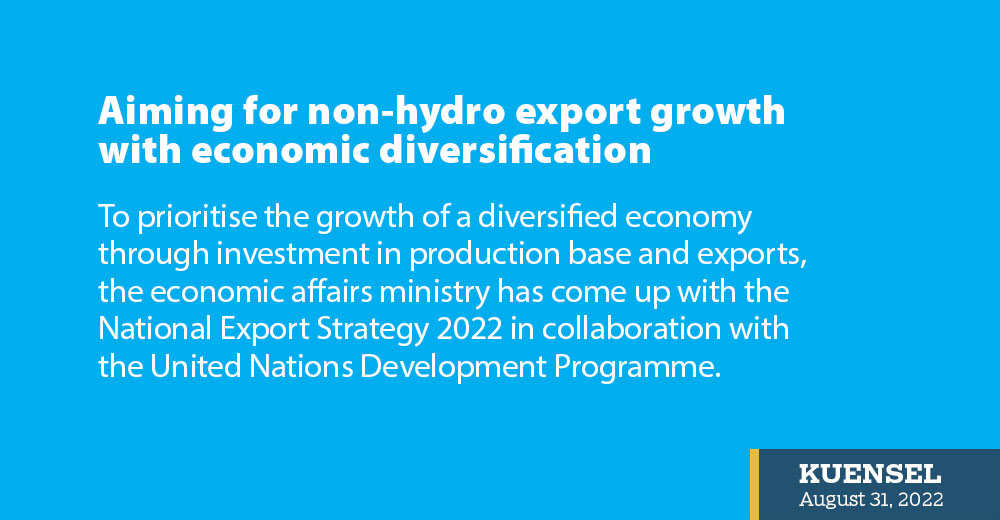Thukten Zangpo
To prioritise the growth of a diversified economy through investment in production base and exports, the economic affairs ministry has come up with the National Export Strategy 2022 in collaboration with the United Nations Development Programme.
The strategy identifies current challenges, outlines opportunities, and recommends policy shifts and interventions to diversify export as Bhutan prepares to put the economy back on track and graduate sustainably from the least developed country status by 2023.
Bhutan’s economy being small, it does not provide economies of scale in production and product development.
However, the strategy states that Bhutan’s export growth should account for country’s resource endowments that include labour and capital, after which the country should, in the short-run, pursue industries or sectors in which the country has a competitive advantage relative to its largest trading partner, India.
It added that the government should account for a competitive advantage in producing certain goods relative to India to ensure maximum economic efficiency. “The comparison for competitive advantage is vital, as the development of an industry that is less competitive than the Indian market would lead to this industry experiencing little to no growth as it would be dependent on the small domestic market rather than having the potential to increase in scale by taking advantage of the large Indian market.”
According to the strategy, the Bhutanese economy base remains narrow because the vast majority of the population is dependent on the highly unproductive primary sector.
“The primary sector engaged close to 50 percent of the total workforce, but it contributed only 19 percent to gross domestic product (GDP).”
When Bhutan experienced the Covid-19 pandemic in 2020, the country’s GDP dropped to 10.08 percent and exports reduced by 33 percent (excluding electricity). The export was reported at Nu 20.73 billion in 2020.
It added that Bhutan’s export for a decade reveals high reliance on a few products, namely ferro-alloys, iron and steel, cement, and dolomite.
Bhutan’s single major export remained concentrated in electricity, contributing 34 percent and 57 percent of the total export in 2019 and 2020, respectively.
Ferro-alloys was the main non-hydro export accounting for 38 percent of the export in 2011, 31 percent and 36 percent in 2019 and 2020, respectively.
Most of the industrial sector is highly concentrated with more than 90 percent of industries in production and manufacturing in the small and cottage category. The manufacturing sector has seen sluggish growth, resulting in undiversified economic growth.
The top 10 export products, mainly minerals and agricultural products in primary form and power intensive industrial products, collectively represent over 80 percent of total exports (excluding electricity), reflecting high reliance on a few products in the export market.
In the last decade, the top 10 exports have contributed an average of 12 percent to GDP.
Similarly, the exports were mostly concentrated in the regional market in India, accounting over 75 percent, followed by Bangladesh at about 20 percent in 2019, it stated.
The strategy recommended seven broad strategies with 41 different recommendations under short, medium and long term.
“The need of the hour is harnessing the potential and creating an enabling environment for product development and entry to the export markets,” the strategy stated.
The study found that the Bhutanese products in the export market have untapped potential in the regional market in terms of volume and product competitiveness.
It identified low productive capacity, lack of testing facilities to meet the sanitary and phytosanitary and technical barriers to trade measures and logistics as barriers.
The strategy recommended supply-side policies and programmes to accelerate production, policy and institutions, trade facilitation, standards and certification, market access, and credit facilities.
It also found inadequacy of the facilities to meet export requirements, such as testing, certification, export information, market access, and shortage of manpower, and transport and transit issues.
Moreover, the change in import policies in the target markets, procedural changes, and fulfillment of sanitary and phytosanitary and technical barriers to trade measures are other areas in which exports face difficulties.
“The expansion of business infrastructure, namely dry ports, industrial parks, cottage and small industry development facilities, commissioning of hydropower projects under construction, on-going activities under CSI flagship programmes, sectoral initiatives, and growth of other enabling facilities show potential for broadening the productive capacity and base,” it recommended.
The department of trade under the economic affairs ministry, in close coordination with other relevant agencies, is implementing the short-term strategies.


